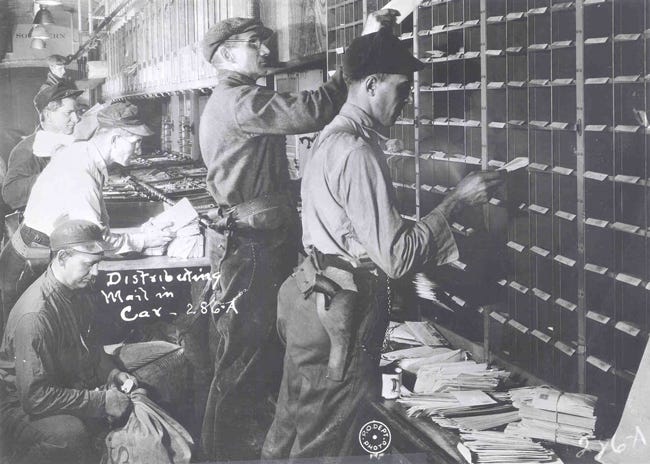Real Reality and Fictional Reality
Where Do You Stop? Chapter 17:
Later I learned that Marvin’s mother was from New Orleans. His father had been a railway mail clerk when he was a young man, traveling in mail cars from North to South and back again, sorting the mail as he rolled along. He had carried a letter of introduction to her family for months but shyness had kept him from using it until, driven by loneliness during a layover, he had at last come to call and fall in love. They—but all that is another story, and I knew none of it at the time.
Me, in Topical Guide 62:
Eric Kraft’s maternal grandfather, Clifford Lyman, was a railway mail clerk. He traveled by train up and down the East Coast, sorting mail. He was away from home for two weeks at a time, living in the caboose of a train and sorting mail in the mail car every day. Then he had two weeks off—two weeks when he could spend hours tinkering in his basement workshop, often accompanied by his grandson.
United States Postal Service, “Photo Gallery: Railroads” (quoted in Topical Guide 62):
Railway mail clerks had one of the toughest jobs in the Post Office Department, sorting mail on swaying and lurching trains from 1864 to 1977. … Trains derailed because of open switches, livestock on the tracks, on-coming trains, broken rails, and washouts, to name a few things. … From the 1870s to the 1950s, railroads were the primary mode of mail transportation in the United States. To speed delivery, clerks rode in the cars, sorting mail en route. In 1921, due to a rash of train robberies following World War I, Postmaster General Will H. Hays armed railway mail clerks, ordering them to shoot to kill to protect the mail. … RPO [Railway Post Office] interiors typically ranged from 15 to 60 feet long and were about 9 feet wide. Tight-knit crews of up to 20 men worked in the larger cars, racing the clock to sort mail in time for dispatch to the stations en route. “Working the mail” consisted of sorting letters into “pigeon hole” distribution cases and tossing mail accurately into labeled pouches, correctly routed to as many as 5,000 destinations. … Clerks had to memorize complex distribution schemes and studied and practiced continuously in order to pass regularly-scheduled examinations. … In the 1950s and 1960s, improved highways, affordable automobiles, and the growing airline industry contributed to a decline in passenger train service. Fewer available trains, along with modern letter sorting machines that rendered much hand-sorting of mail obsolete, spelled the end of an era. On July 1, 1977, at 4:05 a.m., the last Railway Post Office ground to a halt at Union Station in Washington, D.C., after a 5-hour journey from New York City.
See also:
Reality, Real and Fictional TG 27, TG 62, TG 64, TG 76, TG 78, TG 85, TG 127, TG 147, TG 155, TG 488; Real Objects in Fiction TG 132; Reality: Perception of TG 426
Have you missed an episode or two or several?
You can begin reading at the beginning or you can catch up by visiting the archive or consulting the index to the Topical Guide. The Substack serialization of Little Follies begins here; Herb ’n’ Lorna begins here; Reservations Recommended begins here; Where Do You Stop? begins here.
You can listen to the episodes on the Personal History podcast. Begin at the beginning or scroll through the episodes to find what you’ve missed. The Substack podcast reading of Little Follies begins here; Herb ’n’ Lorna begins here; Reservations Recommended begins here; Where Do You Stop? begins here.
You can listen to “My Mother Takes a Tumble” and “Do Clams Bite?” complete and uninterrupted as audiobooks through YouTube.
You can ensure that you never miss a future issue by getting a free subscription. (You can help support the work by choosing a paid subscription instead.)
At Apple Books you can download free eBooks of Little Follies, Herb ’n’ Lorna, and Reservations Recommended.
You’ll find overviews of the entire work in An Introduction to The Personal History, Adventures, Experiences & Observations of Peter Leroy (a pdf document) and at Encyclopedia.com.



